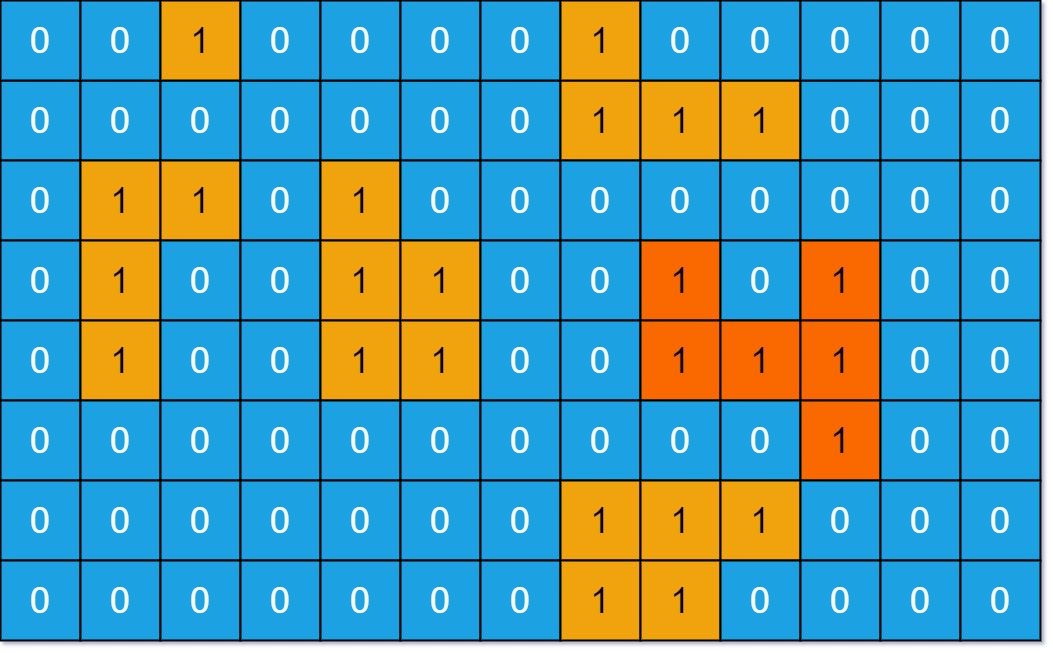Problem 605. Can Place Flowers
-
You have a long flowerbed in which some of the plots are planted, and some are not.
-
However, flowers cannot be planted in adjacent plots.
-
Given an integer array
flowerbedcontaining0's and1's, where0means empty and1means not empty, and an integern, returntrueifnnew flowers can be planted in theflowerbedwithout violating the no-adjacent-flowers rule andfalseotherwise.
Examples
-
Example 1:
- Input: flowerbed = [1,0,0,0,1], n = 1
- Output: true
-
Example 2:
- Input: flowerbed = [1,0,0,0,1], n = 2
- Output: false
Constraints:
1 <= flowerbed.length <= 2 * 10^4flowerbed[i]is0or1.- There are no two adjacent flowers in
flowerbed. 0 <= n <= flowerbed.length
Solution
/**
* @param {number[]} flowerbed
* @param {number} n
* @return {boolean}
*/
var canPlaceFlowers = function(flowerbed, n) {
for (let i = 0; i < flowerbed.length && n > 0; i++) {
if (!flowerbed[i- 1] && !flowerbed[i] && !flowerbed[i+1]) {
flowerbed[i] = 1;
n--;
}
}
return n === 0;
};Problem 695. Max Area of Island
-
You are given an
m x nbinary matrixgrid. An island is a group of1's (representing land) connected 4-directionally (horizontal or vertical.) You may assume all four edges of the grid are surrounded by water. -
The area of an island is the number of cells with a value
1in the island. -
Return the maximum area of an island in
grid. If there is no island, return0.
Example

- Input: grid = [[0,0,1,0,0,0,0,1,0,0,0,0,0],[0,0,0,0,0,0,0,1,1,1,0,0,0],[0,1,1,0,1,0,0,0,0,0,0,0,0],[0,1,0,0,1,1,0,0,1,0,1,0,0],[0,1,0,0,1,1,0,0,1,1,1,0,0],[0,0,0,0,0,0,0,0,0,0,1,0,0],[0,0,0,0,0,0,0,1,1,1,0,0,0],[0,0,0,0,0,0,0,1,1,0,0,0,0]]
- Output: 6
- Explanation: The answer is not 11, because the island must be connected 4-directionally.
Constraints
m == grid.lengthn == grid[i].length1 <= m, n <= 50grid[i][j]is either0or1.
Solution
/**
* @param {number[][]} grid
* @return {number}
*/
var maxAreaOfIsland = function(grid) {
const m = grid.length;
const n = grid[0].length;
let maxArea = 0;
const bfs = (rowIndex, colIndex) => {
const dx = [1, -1, 0, 0];
const dy = [0, 0, 1, -1];
let area = 0;
const queue = [[rowIndex, colIndex]];
while (queue.length) {
const [row, col] = queue.shift();
grid[row][col] = 0;
area += 1;
for (let i = 0; i < dx.length; i++) {
const nextRow = row + dx[i];
const nextCol = col + dy[i];
if (nextRow >= 0 && nextRow < m && nextCol >= 0 && nextCol < n && grid[nextRow][nextCol]) {
queue.push([nextRow, nextCol]);
grid[nextRow][nextCol] = 0;
}
}
}
return area;
};
for (let i = 0; i < m; i++) {
for (let j = 0; j < n; j++) {
if (grid[i][j]) {
maxArea = Math.max(maxArea, bfs(i, j));
}
}
}
return maxArea;
};Problem 1323. Maximum 69 Number
- You are given a positive integer
numconsisting only of digits6and9.
Return the maximum number you can get by changing at most one digit (6 becomes 9, and 9 becomes 6).
Example
-
Example 1:
- Input: num = 9669
- Output: 9969
- Explanation:
- Changing the first digit results in 6669.
- Changing the second digit results in 9969.
- Changing the third digit results in 9699.
- Changing the fourth digit results in 9666.
- The maximum number is 9969.
-
Example 2:
- Input: num = 9996
- Output: 9999
- Explanation:
- Changing the last digit 6 to 9 results in the maximum number.
Constraints
1 <= num <= 10^4numconsists of only6and9digits.
Solution
/**
* @param {number} num
* @return {number}
*/
var maximum69Number = function(num) {
const numStr = num.toString();
const maxNumStr = numStr.replace('6', '9');
return parseInt(maxNumStr);
};